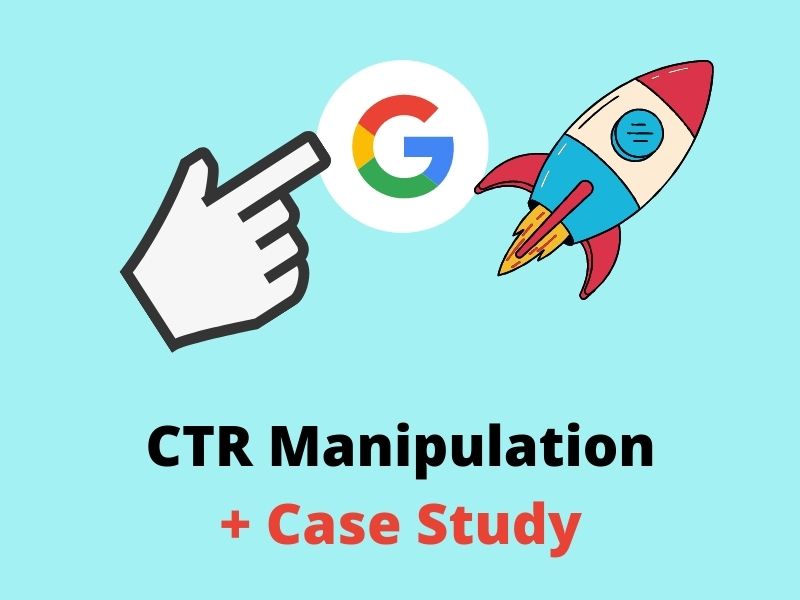The Ultimate Overview to Carrying Out Effective CTR Manipulation Techniques
The Ultimate Overview to Carrying Out Effective CTR Manipulation Techniques
Blog Article
Accomplishing Success With Targeted CTR Adjustment
The optimization of click-through rates (CTR) is an essential undertaking for brand names intending to improve their digital presence and make best use of interaction. Targeted CTR manipulation includes a range of approaches, from data-driven advertisement placements to the development of compelling content customized to particular target markets.
Understanding Click-Through Rates
Click-through prices (CTR) act as a critical statistics in electronic advertising, mirroring the performance of on-line web content in driving customer involvement. This statistics is computed by dividing the number of clicks a promotion or web link gets by the total variety of impacts, revealed as a percent (GMB CTR Manipulation). A greater CTR indicates that the material reverberates well with the target audience, motivating them to take action
Comprehending CTR is essential for marketing experts intending to optimize their campaigns. Various aspects affect CTR, including advertisement positioning, style, and the significance of the content to the audience's rate of interests. Compelling headings and aesthetically enticing images can considerably boost the possibility of users clicking on a link.
Furthermore, the context in which the material is presented plays an essential role in figuring out CTR. Eventually, a thorough understanding of CTR empowers marketers to fine-tune their techniques, making sure that electronic campaigns attain their desired end results properly.
Importance of CTR Adjustment
In the affordable landscape of electronic advertising and marketing, the control of click-through rates (CTR) has become a vital strategy for boosting campaign efficiency. CTR acts as an essential performance indicator, mirroring the efficiency of on-line advertisements and web content in drawing in customer interaction. A greater CTR not only signifies higher rate of interest yet likewise can result in enhanced search engine positions and lower cost-per-click (CPC) rates, thereby optimizing total advertising budgets.
The relevance of CTR control depends on its ability to educate online marketers about client choices and actions. By examining CTR data, businesses can determine which aspects of their projects reverberate most with their target market. This insight permits more informed decision-making and the allocation of resources to one of the most effective networks.
Moreover, effective CTR control cultivates a competitive advantage. Hence, grasping CTR adjustment is not merely advantageous; it is necessary for accomplishing continual success in electronic marketing efforts.
Methods for Targeted CTR
Attaining targeted click-through prices (CTR) calls for a calculated technique that encompasses different strategies customized to certain target market sectors. One reliable method is optimizing advertisement placements by using data analytics to recognize high-performing channels. By concentrating initiatives on these networks, marketing experts can enhance exposure and rise engagement.
An additional essential approach is crafting engaging headlines and contacts us to action (CTAs) A/B testing different variations can reveal which mixes reverberate most with the target audience, thus driving higher CTR. In addition, integrating visual elements such as attractive pictures or videos can considerably enhance allure, making content more shareable and appealing.
Customization likewise plays an important duty; using individual information to produce tailored content can cultivate a feeling of significance, encouraging clicks. Furthermore, leveraging social evidence via testimonials and user-generated content can construct depend on, ultimately boosting CTR.
Analyzing User Habits
 Recognizing customer actions is necessary for maximizing marketing techniques and boosting overall performance. By examining just how customers interact with content, online marketers can acquire useful understandings right into choices, inspirations, and discomfort points. This knowledge enables the development of even more targeted projects that resonate with specific audience segments.
Recognizing customer actions is necessary for maximizing marketing techniques and boosting overall performance. By examining just how customers interact with content, online marketers can acquire useful understandings right into choices, inspirations, and discomfort points. This knowledge enables the development of even more targeted projects that resonate with specific audience segments.To effectively examine individual habits, different tools and methodologies can be employed. Web analytics platforms offer data on user interaction metrics such as click-through prices, bounce rates, and time spent on page. Heatmaps and session recordings allow marketing experts to envision customer communications, disclosing which elements draw in attention and which might be forgotten.
In addition, individual feedback via surveys and responses kinds can use qualitative understandings, enhancing the understanding of user view and contentment. Segmenting customers based upon rate of interests, habits, and demographics can even more improve targeting efforts, customizing web content to fulfill diverse requirements.
Inevitably, constant evaluation of customer habits is essential for adjusting advertising strategies in real-time. As user trends progress, remaining in harmony with these changes makes certain that projects stay relevant and efficient, fostering a much deeper connection with the target market. This foundational understanding establishes the phase for the successful application of targeted CTR adjustment strategies.
Gauging Success and Adjusting Approaches
Measuring success in targeted advertising and marketing projects requires a calculated approach that incorporates performance metrics with recurring analysis. Secret performance signs (KPIs) such as click-through prices (CTR), conversion rates, go and consumer purchase prices must be kept track of constantly to gauge the performance of control techniques. By developing a baseline, marketers can analyze changes in CTR and determine fads that indicate successful involvement or possible shortcomings.
On a regular basis analyzing these metrics permits the prompt adjustment of methods. For instance, if a particular campaign reveals a significant drop in CTR, it might signify the need for creative modifications or a reevaluation of targeting specifications. Using A/B testing can better fine-tune methods by comparing variants of advertisements or touchdown pages, giving insight into what resonates ideal with the target audience.
Additionally, including qualitative comments with studies or customer interviews can supplement quantitative information, supplying an extensive sight of target market assumption. Ultimately, the ability to iteratively analyze and refine approaches based upon real-time information fosters a much more responsive marketing method, making sure that projects stay lined up with business objectives and audience preferences. This adaptive method is important in achieving sustained success in targeted CTR adjustment.
Verdict
In verdict, targeted CTR control is essential for enhancing digital marketing initiatives - CTR Manipulation. Inevitably, successful CTR manipulation not just raises exposure but likewise fosters trust and credibility, thus contributing to continual growth in affordable markets.
 Targeted CTR control includes my response an array of techniques, from data-driven ad placements to the growth of compelling web content customized to particular audiences.Click-through rates (CTR) offer as a vital metric in electronic advertising, reflecting the efficiency of on the internet web content in driving user interaction. A greater CTR suggests that the content resonates well with the target audience, motivating them to take activity.
Targeted CTR control includes my response an array of techniques, from data-driven ad placements to the growth of compelling web content customized to particular audiences.Click-through rates (CTR) offer as a vital metric in electronic advertising, reflecting the efficiency of on the internet web content in driving user interaction. A greater CTR suggests that the content resonates well with the target audience, motivating them to take activity.CTR offers as a key efficiency sign, showing the efficiency of on the internet ads and material in drawing in important link individual interaction.In verdict, targeted CTR control is important for maximizing digital advertising efforts.
Report this page